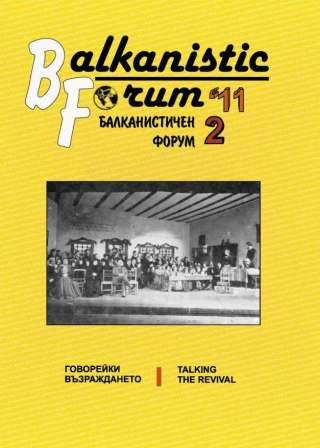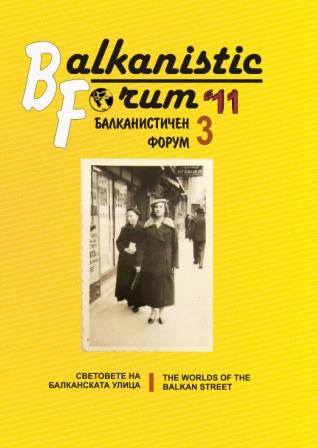
We kindly inform you that, as long as the subject affiliation of our 300.000+ articles is in progress, you might get unsufficient or no results on your third level or second level search. In this case, please broaden your search criteria.


The Romanticism in the Bulgarian and Serbian literature is a complex concept. Its place is not found in literature of both countries or its representatives and more important features too. Some of the critics and the historians of literature argue about the existence of the Romanticism in Bulgaria. Others say it did exist. Its place is not denied in Serbia but there is disagreement about the time limit and the representatives. Here is that this literary school raises serious discussions in the two neighbor countries. The fact is that in the middle of thel 9 century many innovations are entering into the Serbian and Bulgarian literature. This is very clear in the work of authors Milutinovic, Njegos, Karadzic, Rakovski, Chintulov, Kozlev. In their_ works the most important is the fate of society, its past, beliefs, customs and folklore. These works certainly bear the marks of Romanticism, which in South Slavic has got a different nature and functions. Proof is the dialogue between the works of two authors who have got a similar fate and ideas. They are Njegos and Rakovski, representatives of Romanticism in Serbian and Bulgarian literature. Their fundamental works "The Mountain Wreath" - "Forest Wanderer" bear the features of Romanticism, because they reflected the most existential questions, related to society, with its history and traditions, these are exactly the characteristics of the Bulgarian and Serbian literary movement...
More...
The book "My prisons" (Le mie prigioni) written by Silvio Pellico is among the most discussed translated works during the Bulgarian Renaissance. Its publishing in Bulgarian in 1874 creates wide resonance in the society, for which we know from many articles and announcements in the media at that time. The social and history content in the memoirs correspond with the revolutionary developed reality. The work relies on the receptive level of the Renaissance reader with its realistic view of imprisoned life along with the presentation of virtue hero, spiritually in advance to his enemies.
More...
The text offers possible, applicable in the field of academic debate on Bulgarian Renaissance, thematic, conceptual and literary-historical aspects of the consideration of the notion of "Renaissance modernity". Through the challenges of this format of cultural diffusion and influences there is proposed an academic module whose accents have been highlighted as advisable and suggested yet fully realizable territories of lecture choice and philological strategies used by the academic tutor in Renaissance literature in the first decade of the 21 century.
More...
The Bulgarian National Revival literary cannon has been constituted via the first academic history of the Bulgarian literature: „Bulgarian Writers: Life - Creative Work - Ideas", Vol. 1-2, Sofia, 1929. It is a collective work of university lecturers and professional philologists, who have been doing their studies in the 20s of the 20th century. The constitution of the literary cannon has been preceded by a paper war between Mikhail Arnaudov and Vassil Poundev on the pages of the then periodicals. The constitution of the literary cannons in the Roman, German and Slavic literatures happens beyond the 18th century, after the secularization of culture and creation of literary schools during the times of positivism. Probably, gathering of books, being realized as classical literature by profane human values, has been constituted on the analogy of the books gathering in the Holy Writ, in which we read the God's Word to men...
More...
The research is dealing with the echo of the language problem in Cyprus from a historical point of view. It is organized around three axis: it started with the reverberation in Cyprus of the struggle between katarevusa and demotic in Greece from the end of the 19th century. The author follows also the transfer of this struggle in the political-ideological sphere and by the end she considers the intervention of poetry in this debate. The gradual imposition of demotic over the katarevusa represents an important event and at the same time a difficult endeavor in Cyprus. The language adaptation was considered necessary in order the identification of Cyprus with the literary achievements of Greece to be made possible. On one side, the Cyprus Greeks had to adapted to the language reality of their time, on the other side, taking into consideration Greece was imposed as a necessity in "difficult" times and represents political will and conscious choice.
More...

The paper introduces Petar Dinekov in comparison to his predecessors Iv. Shishmanov, Boian Penev and Mihail Arnaudov. In relation to the researchers born in the 1910s-1920s he is defined as "non generational" since they do not state a unity of research approaches to the literary problems of the Revival. The author comments "the absences" in the critical heritage of Dinekov and comments his specific "compiled type" of books as a peculiar refusal of more holistic and profound studies in order to avoid the ideological issues.
More...
The object of analysis is the first published work of P.R. Slavejkov - the poem "Grave" and the works of the first poetic volume "Mixed Bunch". The aim of the observations is to illustrate how in the context of the formation of the Bulgarian literature the stylistic clichti, introduced by the translation, influences the structuring of the spiritual world view and the poetics of the Revival writer. The author emphasizes the motive of death and its semantic restructuring in the context of the elegiac content of the poem and the volume. Using a comparative approach the author introduces the idea that the poetic works of the early Slavejkov should be read not as a sum of single and accidental anonymous translations but as a holistic conceptual text.
More...
The article is a remark to the discussion about the Bulgarian Revival as a differential period in the history of Bulgarians under Ottoman rule. The author emphasizes the voices of the writers and public figures engaged in the discovering of a solution out of the five centuries slavery existence of the people. The writers before the Liberation comment the political relations in Europe, Russia and Ottoman empire in the 19th century and search for a winning strategy about the European future of their nation. The elimination of these voices by the pretending to be influential historiography version of our past, the exclusion from the analysis of the Balkan modernity of the narratives of G. Rakovsky, Hr. Botev, L. Karavelov and their followers is not scientifically correct and in this sense manipulative, away from the "intention of truth". The reflexivity could not overcome the direct engagement with the national, if based in the deliberative silencing of the voices of the authorities by their time.
More...
The article comments the methodological potential of the publications in the "Bulgarian language and literature" journal devoted to the Revival literature. The author is convinced that the present day lectures on Revival literature should developed the notion of the Bulgarian Revival as a holistic cultural and literature meta-text to allow the students to reflect on the contemporary society and public figures. The disrupting of the totality of reception of the Revival i^ipoque in the student consciousness by dividing the lectures in different school years, manuals and interpretation terms which could be taken as evaluative would disrupt the process of creating such notion.
More...

The paper deals with the interaction between literature and painting art in the search of effective decisions for expressing the advancing changes in the spiritual and material world of the Bulgarians. The author is interested in the attempts to correlate and supplement of iconic and text images. Word and icon meet to complement and to change their roles. Interesting versions of this meeting offer historical plots and images in which the figures of lion and horseman, as followed in the hand-written and printed texts of the 18th and 19th century glyptic. The second part of the paper researches plots from the April's revolt developed by two self-educated painters from Koprivshtitsa - Todor Shabanov and Hristo Koev.
More...
Istorija slavjanobalgarska is written in a strange and even chaotic mixture of Church Slavonic and New Bulgarian vernacular. It has often been claimed that Paisij tried to write basically in New Bulgarian but did not quite succeed. However, if he had wanted to write in the vernacular, he could easily have done so, since there existed a fully developed vernacular pattern in the many damaskini manuscripts, including those of his prolific contemporary Josif Bradati. This gives rise to the question why Paisij didn't follow the example of Josif and many other writers of damaskini: that is, why didn't he simply copy the New Bulgarian vernacular pattern from religious manuscripts? The answer lies in the aim of Paisij's book and the linguistic conception on which it was based. Istorija slavjanobalgarska is fiercely anti-Hellenistic. In this respect, it differs radically from the religious literature of the time. The book is aimed not only, or even mainly, at ordinary illiterate Bulgarians. On the contrary, it is intended for those who had social ambitions, i.e., those who were at risk of giving up their “Bulgarianness" and become Hellenized.
More...
The aim of the suggested report is to present the book "Life description ofY. Iv. Venelin" (Odessa, 1851) as: 1. a "snapshot" of the narrative skills of the Bulgarian author and of the type of the "Hero", which the Bulgarian literature sacralized in the middle of toe 19th century by describing the life of Venelin; 2. A text which stabilizes but also activates the manifestations of the cult to Venelin among the Bulgarians. The conclusions of the analysis are: 1. the typical syncretism of the Bulgarian literature created by the middle of the 19th century is manifested in toe book; 2. the interest of the Bulgarian literature towards Venelin intensifies exactly in the years following the publishing of the examined book.
More...
The paper deals with the Balkan street as a lieu de memoire (according Pierre Nora.s notion) and explores the ways of construction of collective (national and cultural) memory. The research focuses on the Bulgarian case which is compared with Serbia, Romania, Albania, and FYROM. In the paper the Balkan street is presented as a commemorative site of memory through analysis of memorial plaques. On the second place, the Balkan street is viewed as a symbolic site of memory by means of research of street names and graffiti.
More...

In this paper I propose to analyze in short the changes of the building that occurred in the Bulgarian capital between the 19th and the beginning of the 20th century.
More...
I my research I follow the enormous energy and endeavor of the Thessalonica Bulgarian society -Bulgarian traders, book sellers, teachers and craftsmen -inhabiting the Bulgarian streets of Thessalonica. Many of them took an active part in the school and church affairs long before 1880.
More...
The present article will try to shed some light on the process of transformation of the family memory of the Balkan wars into war narratives, as well as on some of the specific features and social functions of that narrative.
More...